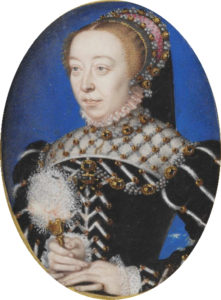The black legend that has surrounded Catherine de Medici (1519-1589) since her stint as regent of France for her three eldest sons has made her one of history’s most infamous women — poisoner, fan of the occult and the supposed mastermind behind the St Bartholomew’s Day Massacre in 1572. Just how much of this is true and how much of this are attempts to undermine a woman who ruled France for 30 years in a time of extreme religious tension?
Born in 1519, Caterina Maria Romola di Lorenzo de Medici was the daughter of Lorenzo de Medici, Duke of Urbino and ruler of Florence. The Medici family was one of Italy’s most influential families, making their fortune in the fifteenth century as bankers. Catherine was orphaned within a year of her birth: both parents died of the plague within a few weeks of each other. Her future was to be decided by her powerful uncle, Pope Clement VII. Clement used his own power and connections to snare for Catherine the sullen Henry, second son of Francis I of France. While the Medicis were incredibly rich and powerful, their background as bankers was more associated with the middle classes rather the elite and titled ruling class.
Catherine married Henry at 14, but her powerful protector Clement died the following the year, leaving her with less political clout. Several years later, Henry’s older brother, the Dauphin of France, died, leaving Henry and Catherine as the future King and Queen of France. Although Catherine loved Henry, he was infatuated with his mistress Diane de Poitiers (who was 19 years his senior). It was Diane who had to persuade Henry to join Catherine in bed so they could produce heirs for France. Catherine was very much on the sidelines with no power during her husband’s 12-year reign. During this time, the couple had 10 children.
When Henry died in 1559 after being wounded in a jousting accident, Catherine was thrust into the political arena. Her eldest son, Francis II, was only 15 and sickly, dying just 16 months after ascending the throne. Catherine acted as regent for her second son, Charles IX, who was only 10 when he became King of France. Catherine ruled over France for her son’s 14-year reign as ‘Governor of the Kingdom.’ At this time, Europe was a place of religious tension between the Catholics and Protestants, called huguenots in France. Initially, Catherine opted for a policy of religious tolerance, much like Elizabeth I of England, although the royal family remained predominantly Catholic. As a way to bring the two parties together, she arranged for her youngest daughter, Margot, to marry her cousin, the huguenot Henry of Navarre. The wedding was a catalyst for the event which has stained Catherine’s reputation for centuries: the St Bartholomew’s Day Massacre. Many huguenots were in Paris for the wedding, and Catherine ordered the assassination of Gaspard de Coligny, Admiral of France, a prominent huguenot and someone Catherine felt had too much sway over her son, Charles. She was not just concerned about being displaced — she disagreed with Coligny’s policy of war with their powerful neighbor, Spain. Unfortunately, Paris, which was very Catholic, saw this as a signal to begin a rampage, and they began to murder huguenots all over the city, many of whom were there to see Henry of Navarre get married. Henry himself was in danger and had to be protected by his new wife, Margot. This massacre spread to other parts of France and there was nothing Catherine could do to stop the massacre her actions had started.
After the death of Charles at just 23, Catherine’s third (and widely considered favourite) son became Henry III. While she didn’t have as much control during Henry’s reign as she did during the previous two reigns, she still worked hard to make his reign a success. Sadly this was not to be; Henry was a vain and malicious king and his assassination in 1589 was greeted with joy. Catherine died 8 months later, worn out by ruling for her sons. She was so hated by this point that the Parisians threatened to throw her body in the Seine if it was brought into Paris.

